by Melanie Knowles and Robert Misbrener
Ā鶹¾«Ń” (KSU) installed nearly 4 megawatts of ground- and roof-mounted solar panels in the last year and has plans to add up to 6 additional megawatts in the coming year. KSUās commitment to alternative energy improves its microgrid capabilities, diversity, and reliability, positioning it for manageable utility costs over the next 25 years. This investment in solar energy aligns with KSUās vision: āTo be a community of change agents whose collective commitment to learning sparks epic thinking, meaningful voice and invaluable outcomes to better our society.ā
KSU is a public research university with an enrollment of over 38,000 students and 8 million sq. ft. of building area. The Kent Campus is located on 941 acres in Kent, Ohio, and is one of the largest universities in Ohio, with 11 Leadership in Energy and Environmental Design (LEED)-certified buildings. The university also includes seven regional campuses in northeastern Ohio and additional facilities in the region and internationally.
The State of the Global Climate 2020 report by the World Meteorological Organization of the United Nations (UN), released on April 19, 2021, shows that the previous year was one of the hottest on record. Greenhouse gas concentrations have increased, despite the pandemic-related economic slowdown. At a press conference presenting the details of the report, UN Secretary-General AntĆ³nio Guterres warned that 2021 must be the year of action for protecting people against the ādisastrousā effects of climate change: āTime is fast running out to meet the goals of the Paris Agreement. We need to do more, and faster, now.ā Ā鶹¾«Ń” is proud to be doing more, and fasterānowāto reduce our carbon footprint.
Solar power is an important component to a more sustainable, carbon-free, and cooler energy future. The carbon footprint needed to produce, ship, and install solar panels is often referenced to be offset in about 3 years of operation. Solar panel operational lifespan is over 25 years. While solar is increasingly attractive, the decision of when and where to implement it can be complex. At a public university where the priority is to support students and research, the financial benefit (or at least neutrality) of such a measure must be solid. The university must be a good steward of tuition dollars while advancing sustainability.
Ā鶹¾«Ń”has worked to address energy at multiple levels. The first priority is to reduce demand. Energy-efficiency retrofits have reduced our energy consumption by about 24% at our Kent campus and about 34% at our regional campuses. Energy-efficiency campaigns such as the annual residence-hall competition āDo It in the Dark,ā along with reminders to turn off and unplug during peak load days and over breaks, support energy-saving behavior change. For the energy that is still required, we then consider its source.
The power system in our region has multiple layers affecting the production and purchase of electricity. There are organizations that coordinate the activities of the electric power system, and organizations that generate, transmit, and distribute the electricity for customer consumption. In some areas these functions are done by a single organization. Customers are denoted as electric loads.
Some customers purchase all their electricity requirements from the electric grid. Others self-generate a portion (sometimes all) of their electricity requirements and purchase the remainder from the electric grid. KSU self-generates a portion of our electricity requirements and purchases the balance from the electric grid. We use natural-gas-fired combustion turbines and capture the heat from them to produce steam for campus heating and cooling use. This suite of technologies is known as a combined heat and power (CHP) plant and is one of the most efficient means of energy use. We received the U.S. Environmental Protection Agency (EPA) Energy Star Combined Heat and Power Award in 2007.
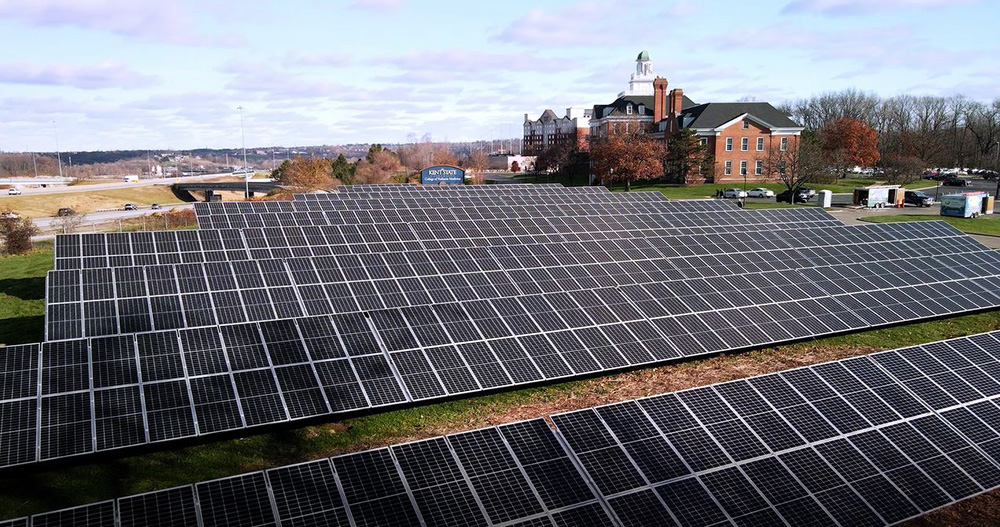
Ā鶹¾«Ń”College of Podiatric Medicine, 315.2-kWdc solar photovoltaic (PV) array. Ground, fixed-tilt mounting.
The Federal Energy Regulatory Commission (FERC) has jurisdiction/regulation over certain portions of the overall electric power system. The next level of jurisdiction/regulation after FERC are the regional transmission organizations (RTOs), and the next level after RTOs is typically the state public utilities commission. In Ohio, this is the Public Utilities Commission of Ohio (PUCO). The PUCO has jurisdiction/regulation over the legacy host utilities in the state. Each of these organizations has regulations that impact facets of the electric power system.
The coordination of the activities of the electric power system in this area is done by PJM Interconnection, which is the RTO that services 13 states and the District of Columbia. PJM is regulated by FERC. Ohio has a deregulated competitive electric power system for power generation. Customers can choose which organization they purchase their electrical energy from; however, they must use PJM and the legacy host utility to deliver the electricity they consume.
Ā鶹¾«Ń”at Ashtabula Campus, 864-kWdc solar PV array. Ground, single-axis tracking.
Customers can choose the certified retail electric service supplier (CRES) they want to purchase their power from. If you do not choose to purchase electricity from a CRES, the legacy host utility will supply electrical energy to you using what is denoted as the standard service offer (SSO). There are numerous CRES organizations that operate in the PJM RTO. PJM coordinates with the organizations that generate and transmit large or bulk electrical supplies to the legacy-regulated host utilities.
The legacy-regulated host utility in northern Ohio is First Energy Corporation (FEC) and Ohio Edison (OE), a subsidiary of FEC, and is the legacy-regulated host utility in the Kent area. PJM will interact at times with FEC as required. FEC/OE continues the transmission and distribution of electricity to the customers in the Kent area.
The invoice for electricity used by the customers is a combination of the electric energy (kWh) purchased from the CRES or SSO, transmission and tariff costs associated with PJM, and transmission and distribution tariff costs associated with FEC/OE. Depending upon a variety of factors, such as the size or kWh usage of the load or the voltage that serves the load, there are wide variations of options and methods to purchase electricity. This results in differences in how customers are invoiced for electricity. In general, the complexity of the electricity invoice ranges from the residential invoice, which is the simplest version, to complex invoices for large electric power consumers. Due to the diverse nature of the electric loads at KSU, our electricity invoices range from the simplest versions to very complex versions.
Solar photovoltaic (PV) electricity is best connected ābehind the meterā so that the solar electricity is used first and the utility electricity flows through the utility ānet meterā only as needed. A net meter is required in Ohio, and tracks electricity flow into the facility from the utility, and solar electricity flow from the facility into the utility grid. Solar PV systems are sized to produce less than is required by the facility on an annual basis. In this case, the solar electricity produced is subtracted from the utility-grid electricity.
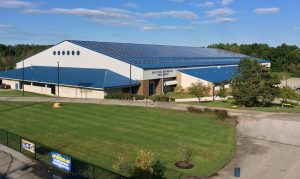
Ā鶹¾«Ń”at Kent Campus, 463-kWdc solar PV array. Non-penetrating, metal roof-mounted, operational July 20, 2012.
It is not cost effective to flow more solar electricity into the grid on an annual basis, because Ohio law requires the utility to pay the facility only the generation-cost portion of each kWh, not including the transmission- and distribution-cost portions. A few states do not require any net meter tracking for solar electricity. In those cases, the utility grid receives free electricity on a bright sunny day with light energy use at the customerās facility.
The Kent Campus CHP is about twice as efficient as a utility power plant, and provides electricity, steam, and chilled water through much of the campus. The main reason for our doubled efficiency is that we capture, convert, and use the waste heat (as steam) from power production, and utility power plants usually do not. As a distributed onsite energy source, the campus also benefits from reduced-transmission wire length loss. These factors, which improve efficiency of energy production and transmission, also reduce the cost of electricity. While this is cost effective for the university, it makes the financial cost benefit of solar more difficult to achieve.

Ā鶹¾«Ń”at Geauga Campus, 322-kWdc solar PV array. Ground, fixed-tilt mounting.
For Kent Campus buildings located beyond the campus grid and for Kent Stateās regional campuses, solar energy becomes more financially viable, especially through a power purchase agreement (PPA), which allows a third party to benefit from tax incentives not available to a public university. A PPA requires Ā鶹¾«Ń”to purchase all the solar electricity produced at negotiated rates for a contracted period, often 25 years. However, Ā鶹¾«Ń”has very little upfront capital expense for the system.
In 2011, Ā鶹¾«Ń”commissioned a comprehensive Renewable Energy Master Plan in an effort to responsibly and efficiently apply appropriate renewable energy methods throughout its campuses. This study was helpful to identify general solar PV viability and our single wind-power viability location at the Ashtabula Campus. Wind power is not being explored due to cost, equipment complexity, repair needs, and environmental study requirements. Solar PV implementation was determined to be the most cost effective and reliable and has minimal maintenance requirements.
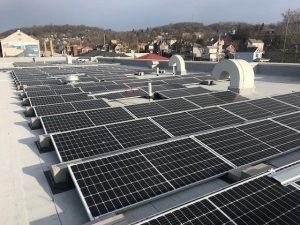
Ā鶹¾«Ń”at East Liverpool Campus, 93-kWdc solar PV array. Non-penetrating ballasted system roof mounting.
Kent Stateās first solar array was installed on the roof of the Field House at the Kent Campus, which is beyond the campus grid. At the time it was completed in the summer of 2012, it was the largest, roof-mounted solar PV panel electrical system within the University System of Ohio. Working with a solar power developer, KSU officially began power production from the installed solar panels in Field House 1 on July 20, 2012. Electricity from the solar panels provides about one-third of the electricity required for the combined Field House and Dix Stadium facilities. Since the two facilities are electrically interconnected, both benefit from the solar panel project. This project became a model for other Ā鶹¾«Ń”solar PV systems.
Renewed interest by KSUās leadership in solar PV led in 2020-21 to Ā鶹¾«Ń”adding solar arrays at six of our regional campuses and the Ā鶹¾«Ń”College of Podiatric Medicine, increasing our solar energy capacity by 3.8 megawatts. A solar power developer engineers, procures, operates, and finances the turnkey large solar photovoltaic systems located at KSUās regional campuses: Ashtabula, East Liverpool, Geauga, Salem, Stark, and Trumbull.
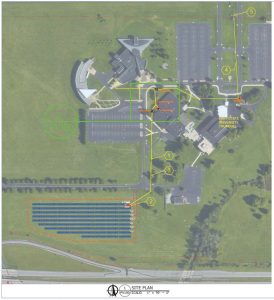
Ā鶹¾«Ń”at Trumbull Campus, 1,314-kWdc solar PV array. Ground, fixed-tilt mounting.
KSU is under a PPA with a firm whose team installed, owns, maintains, and operates the systems in accordance with the Ohio Revised Code. There are four ground-mounted arrays (three fixed-mount and one single-axis tracking), and five rooftop solar PV systems at the regional campuses (see Figure 1). The university preferred a maximum 25-year total PPA contract in almost every case to maximize savings over grid-supplied electric power. While contributing to the environmental benefits of solar power, these regional and satellite campus solar arrays are also projected to save the university about $2 million over 25 years. Every year, the solar PV arrays installed to date are projected to reduce the Ā鶹¾«Ń”carbon footprint by 4,116 tons of CO2āan emissions reduction equivalent to removing 802 cars from the roads or burning 420,121 gallons of gasoline!
Up to an additional 6 megawatts of ground-mounted solar photovoltaic panels will be installed on a vacant site just east of Kent Campus. This system will include a battery energy storage system (BESS). The project will connect underground to the campus 13.2-kW internal distribution grid (behind the utility meter). This system, combined with the existing CHP plant, will be a microgrid with operational and cost benefits along with flexibility and resiliency. The BESS makes the project cost effective. The system is planned to be operational by late summer 2022.
Figure 1. Ā鶹¾«Ń”Solar Installations.
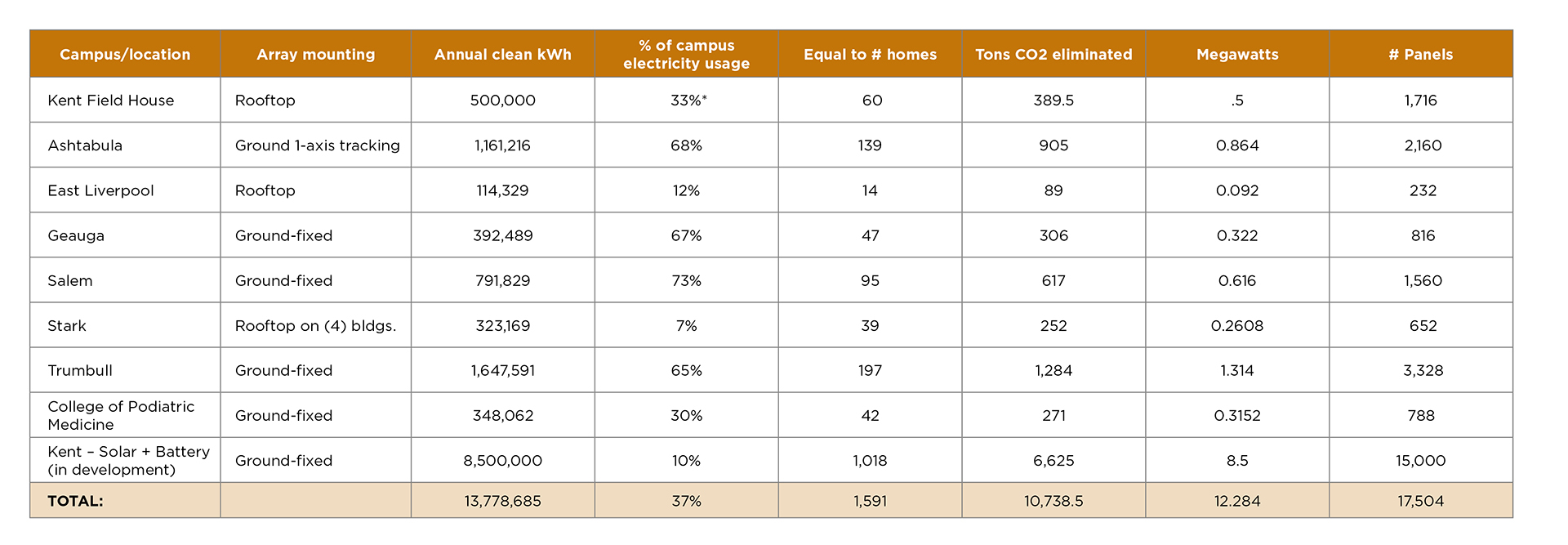
Melanie Knowles is sustainability manager at Ā鶹¾«Ń”, Kent, OH; she can be reached at mknowle1@kent.edu. Robert Misbrener is project manager at KSU and can be reached at rmisbren@kent.edu. This is their first article for Facilities Manager.
